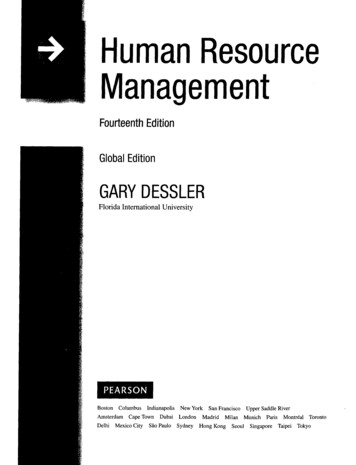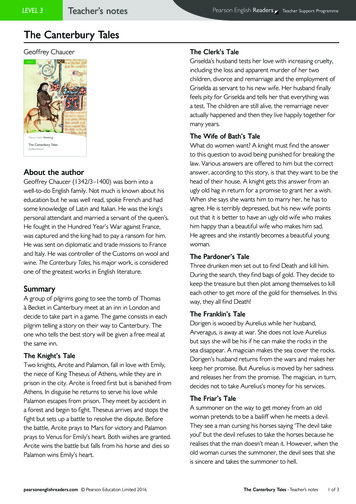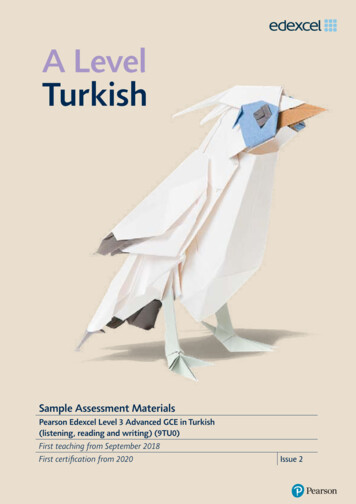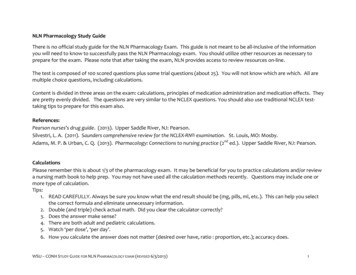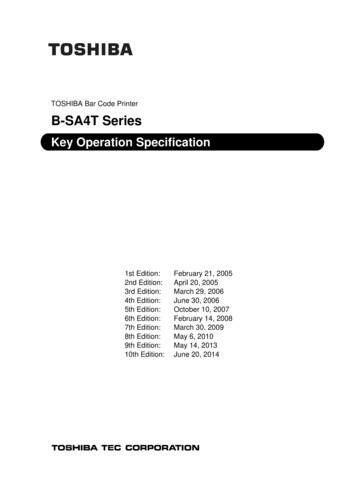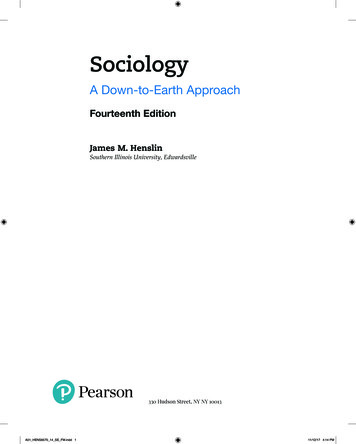
Transcription
SociologyA Down-to-Earth ApproachFourteenth EditionJames M. HenslinSouthern Illinois University, Edwardsville330 Hudson Street, NY NY 10013A01 HENS6570 14 SE FM.indd 111/12/17 4:14 PM
VP, Product Development: Dickson MusslewhiteSenior Acquisitions Editor: Jeff MarshallEditorial Assistant: Christina WinterburnDevelopment Editor: Jennifer Auvil (OPS)Program Team Lead: Amber MackeyContent Producer: Mary DonovanDirector of Field Marketing: Jonathan CottrellField Marketer: Brittany Pogue-Mohammed AcostaOperations Manager: Mary FischerOperations Specialist: Mary Ann GloriandeDirector of Design: Blair BrownCover Art Director: Kathryn FootCover Design: LuminaDigital Studio Project Manager: Rich BarnesFull-Service Project Management and Composition: IntegraPrinter/Binder: LSC Communications, IncCover Printer: Phoenix Color/HagerstownAcknowledgments of third party content appear on pages CR-1–CR-7, which constitutes anextension of this copyright page. Cultural Diversity Around the World: Doing Business in theGlobal Village box contains art with the following credit: Demashita! Powerpuff Girls Z 2009Cartoon Network, Toei Animation & Aniplex. All Rights Reserved. THE POWERPUFF GIRLSand all related characters and elements are trademarks of and Cartoon Network.Copyright 2019, 2017, 2014, 2012 by James M. Henslin. All Rights Reserved. Printed in theUnited States of America. This publication is protected by copyright, and permission should beobtained from the publisher prior to any prohibited reproduction, storage in a retrieval system,or transmission in any form or by any means, electronic, mechanical, photocopying, recording, or otherwise. For information regarding permissions, request forms and the appropriatecontacts within the Pearson Rights & Permissions Department, please visit www.pearsoned.com/permissions/.PEARSON and ALWAYS LEARNING are exclusive trademarks owned by Pearson Education,Inc. or its affiliates in the United States and/or other countries.Unless otherwise indicated herein, any third-party trademarks that may appear in this workare the property of their respective owners and any references to third-party trademarks, logosor other trade dress are for demonstrative or descriptive purposes only. Such references are notintended to imply any sponsorship, endorsement, authorization, or promotion of Pearson’sproducts by the owners of such marks, or any relationship between the owner and PearsonEducation, Inc. or its affiliates, authors, licensees or distributors.Library of Congress Cataloging-in-Publication DataNames: Henslin, James M., author.Title: Sociology: a down-to-earth approach / James M. Henslin, SouthernIllinois University, Edwardsville.Other titles: Down to earth sociology.Description: Fourteenth Edition. Boston : Pearson, [2017] Revised editionof the author’s Down to earth sociology, 2007.Identifiers: LCCN 2017034725 ISBN 9780134736570 (se : alk. paper) ISBN 9780134739991 (aie : alk. paper) ISBN 9780134205571 (Student Edition) ISBN 9780134740072 (etext 2)Subjects: LCSH: Sociology. United States—Social conditions.Classification: LCC HM586.D68 2017 DDC 301—dc23LC record available at https://lccn.loc.gov/2017034725117Rental Edition:ISBN-10:0-13-473657-5ISBN-13: 978-0-13-473657-0Revel ACISBN-10:0-13-474004-1ISBN-13: 978-0-13-474004-1ALCISBN-10:0-13-474000-9ISBN-13: 978-0-13-474000-3Instructor’s Resource EditionISBN-10:0-13-473999-XISBN-13: 978-0-13-473999-1A01 HENS6570 14 SE FM.indd 211/12/17 4:14 PM
To my fellow sociologists,who do such creative research on social life andwho communicate the sociological imaginationto generations of students. With my sincereadmiration and appreciation.A01 HENS6570 14 SE FM.indd 311/12/17 4:14 PM
Brief Contents1The Sociological Perspective 112Race and Ethnicity 3332Culture 3313Aging and the Elderly 3733Socialization 6314The Economy 4014Social Structure and SocialInteraction 9615Politics 4365How Sociologists Do Research 12816Marriage and Family 6Societies to Social Networks 14917Education 5027Bureaucracy and FormalOrganizations 17518Religion 53019Medicine and Health 5638Deviance and Social Control 19920Population and Urbanization 5959Global Stratification 2322110Social Class in the United States 265Collective Behavior and SocialMovements 63211Sex and Gender 30022Social Change and the Environment 660468ivA01 HENS6570 14 SE FM.indd 411/12/17 4:14 PM
ContentsTo the Student from the Author xxTo the Instructor from the Author xxxviiiThe Sociological Perspective 1The Sociological Perspective Seeing the Broader Social Context The Global Context—and the Local 334Sociology and the Other Sciences The Natural Sciences The Social Sciences 555ANTHROPOLOGY 6 ECONOMICS 6 POLITICAL SCIENCE 6 PSYCHOLOGY 6 SOCIOLOGY 6The Goals of Science The Risks of Being a Sociologist 78Origins of Sociology Tradition versus Science Auguste Comte and Positivism Herbert Spencer and Social Darwinism Karl Marx and Class Conflict Emile Durkheim and Social Integration APPLYING DURKHEIM8899101112Max Weber and the Protestant Ethic 13RELIGION AND THE ORIGIN OF CAPITALISM13Values in Sociological Research 14Verstehen and Social Facts 15Weber and Verstehen 15Durkheim and Social Facts 15How Social Facts and Verstehen Fit Together 16Sociology in North America Sexism at the Time: Women in Early Sociology Racism at the Time: W. E. B. Du Bois Jane Addams: Sociologist and Social Reformer Talcott Parsons and C. Wright Mills: Theoryversus Reform The Continuing Tension: Basic, Applied,and Public Sociology 161619202121BASIC SOCIOLOGY 21 APPLIED SOCIOLOGY 21 PUBLIC SOCIOLOGY 23 SOCIAL REFORM IS RISKY 23Theoretical Perspectives in Sociology Symbolic Interactionism SYMBOLS IN EVERYDAY LIFEINTERACTIONISM 25242424 APPLYING SYMBOLICFunctional Analysis ROBERT MERTON AND FUNCTIONALISMAPPLYING FUNCTIONAL ANALYSIS 272626 27KARL MARX AND CONFLICT THEORY 27 CONFLICTTHEORY TODAY 28 FEMINISTS AND CONFLICTTHEORY 29 APPLYING CONFLICT THEORY 29xxiAbout the Author 1Conflict Theory Putting the Theoretical Perspectives Together Levels of Analysis: Macro and Micro 2929Trends Shaping the Future of Sociology Tension in Sociology: Research versus Reform 3030THREE STAGES IN SOCIOLOGYORIENTATIONS 3030 DIVERSITY OFGlobalization 31HOW GLOBALIZATION APPLIES TO THIS TEXTSummary and Review 31Thinking Critically about Chapter 123132Culture 33What Is Culture? Culture and Taken-for-Granted Orientations to Life Practicing Cultural Relativism ATTACK ON CULTURAL RELATIVISM35353839Components of Symbolic Culture 41Gestures 41MISUNDERSTANDING AND OFFENSEGESTURES? 4241 UNIVERSALLanguage 42LANGUAGE ALLOWS HUMAN EXPERIENCE TO BECUMULATIVE 43 LANGUAGE PROVIDES A SOCIALOR SHARED PAST 43 LANGUAGE PROVIDES A SOCIALOR SHARED FUTURE 43 LANGUAGE ALLOWS SHAREDPERSPECTIVES 43 LANGUAGE ALLOWS SHARED,GOAL-DIRECTED BEHAVIOR 44Language and Perception: The Sapir-WhorfHypothesis 45Values, Norms, and Sanctions 46Folkways, Mores, and Taboos 47Many Cultural Worlds 48Subcultures 48Countercultures 51Values in U.S. Society An Overview of U.S. Values Value Clusters Value Contradictions An Emerging Value Cluster When Values Clash Values as Distorting Lenses “Ideal” Culture Versus “Real” Culture 5151525353555555Cultural Universals Sociobiology and Human Behavior Technology in the Global Village 555657vA01 HENS6570 14 SE FM.indd 511/12/17 4:14 PM
vi ContentsNew Technology Cultural Lag and Cultural Change Technology and Cultural Leveling 575959CULTURAL DIFFUSION 59 COMMUNICATION ANDTRAVEL 60 CULTURAL LEVELING 60Summary and Review 61Thinking Critically about Chapter 23“BRING YOUR PARENTS TO WORK DAY”Society Makes Us Human Feral Children Isolated Children Institutionalized Children 65666667THE ORPHANAGE EXPERIMENT IN THE UNITED STATES 67 THE ORPHANAGE EXPERIMENT IN ROMANIA 68 TIMING AND HUMAN DEVELOPMENT: THE CASE OF GENIE 68Deprived Animals 68Socialization into the Self and Mind Cooley and the Looking-Glass Self Mead and Role Taking Piaget and the Development of Reasoning Global Aspects of the Self and Reasoning 6969707172Learning Personality, Morality, and Emotions Freud and the Development of Personality 727273Kohlberg and the Development of Morality 73KOHLBERG’S THEORY 73 CRITICISMS OF KOHLBERG 74 RESEARCH WITH BABIES 74 THE CULTURAL RELATIVITYOF MORALITY 74Socialization into Emotions 74Society within Us: The Self and Emotionsas a Social Mirror Socialization into Gender Learning the Gender Map Gender Messages in the Family 77 TOYS AND PLAY797677 SAME-SEX7980TELEVISION, MOVIES, AND CARTOONS 80 VIDEO GAMES 80 ADVERTISING 80Agents of Socialization The Family SOCIAL CLASS AND TYPE OF WORKSOCIAL CLASS AND PLAY 8291THE EARLY MIDDLE YEARS (AGES 30–49) 91 THE LATER MIDDLE YEARS (AGES 50–65) 92The Older Years (about age 65 on) 92THE TRANSITIONAL OLDER YEARS (AGES 65–74)THE LATER OLDER YEARS (AGE 75 OR SO) 9292 Are We Prisoners of Socialization? Summary and Review 94Thinking Critically about Chapter 349395Social Structure and Social Interaction 96Levels of Sociological Analysis Macrosociology and Microsociology 9898The Macrosociological Perspective: Social Structure 99The Sociological Significance of Social Structure 99Components of Social Structure 100Culture 101Social Class 101Social Status 101STATUS SETS 101 ASCRIBED AND ACHIEVEDSTATUSES 101 STATUS SYMBOLS 102 MASTERSTATUSES 102 STATUS INCONSISTENCY 102Roles 103Groups 103THE FUNCTIONALIST PERSPECTIVETHE CONFLICT PERSPECTIVE 106767677Gender Messages from Peers Gender Messages in the Mass Media 818282 The Neighborhood 82Religion 83Day Care 83The School 84Peer Groups 85The Workplace 87Resocialization 87Total Institutions 87A01 HENS6570 14 SE FM.indd 691Social Institutions Comparing Functionalist and Conflict Perspectives GLOBAL EMOTIONS 74 EXPRESSING EMOTIONS:“GENDER RULES” 74 THE EXTENT OF “FEELINGRULES” 75 WHAT WE FEEL 75 RESEARCHNEEDED 75PARENTSPARENTS89899091The Middle Years (ages 30–65) 62Socialization 63SOCIOLOGICAL EVALUATIONSocialization through the Life Course Childhood (from birth to about age 12) Adolescence (ages 13–17) Transitional Adulthood (ages 18–29) 104104104 Changes in Social Structure What Holds Society Together? 106106MECHANICAL AND ORGANIC SOLIDARITY 106 GEMEINSCHAFT AND GESELLSCHAFT 107 HOW RELEVANT ARE THESE CONCEPTS TODAY? 107The Microsociological Perspective: Social Interactionin Everyday Life 109Symbolic Interaction 109Stereotypes in Everyday Life 109Personal Space 113Eye Contact 114Smiling 114Body Language 114APPLIED BODY LANGUAGE114Dramaturgy: The Presentation of Self in Everyday Life 114Stages 115Role Performance, Conflict, and Strain 115Sign-Vehicles 116Teamwork 118Becoming the Roles We Play 118APPLYING IMPRESSION MANAGEMENT118Ethnomethodology: Uncovering Background Assumptions 11911/12/17 4:14 PM
viiContentsThe Social Construction of Reality Gynecological Examinations 120121In-Groups and Out-Groups The Need for Both Macrosociology and Microsociology 122Reference Groups Summary and Review 126Thinking Critically about Chapter 45128130Common Sense and the Need for Sociological Research 130A Research Model 1. Selecting a Topic 2. Defining the Problem 3. Reviewing the Literature 4. Formulating a Hypothesis 5. Choosing a Research Method 6. Collecting the Data 7. Analyzing the Results 8. Sharing the Results 130130131131131131131132132Research Methods (Designs) 133Surveys 134SELECTING A SAMPLE 134 ASKING NEUTRALQUESTIONS 134 QUESTIONNAIRES ANDINTERVIEWS 136 ESTABLISHING RAPPORT 136Gender in Sociological Research 143Ethics in Sociological Research Protecting the Subjects: The Brajuha Research Misleading the Subjects: The Humphreys Research 144144145How Research and Theory Work Together The Real World: When the Ideal Meets the Real Connecting Research and Theory 146146147148Societies to Social Networks 149Societies and Their Transformation 151Hunting and Gathering Societies 151Pastoral and Horticultural Societies 153Agricultural Societies 153Industrial Societies 154Postindustrial (Information) Societies 154Biotech Societies: Is a New Type of SocietyEmerging? 155Groups within Society Primary Groups PRODUCING A MIRROR WITHINSecondary Groups A01 HENS6570 14 SE FM.indd 7160160THE SMALL WORLD PHENOMENON 162 IS THE SMALLWORLD PHENOMENON AN ACADEMIC MYTH? 162 BUILDING UNINTENTIONAL BARRIERS 163Group Dynamics Effects of Group Size on Stability and Intimacy Effects of Group Size on Attitudes and Behavior 156157157157164164165LABORATORY FINDINGS AND THE REAL WORLD 166Leadership 168WHO BECOMES A LEADER? 168 TYPES OF LEADERS 169 LEADERSHIP STYLES 169 LEADERSHIP STYLES IN CHANGINGSITUATIONS 169The Power of Peer Pressure: The Asch Experiment The Power of Authority: The Milgram Experiment Individual and Global Consequences of GroupDynamics: Groupthink PREVENTING GROUPTHINK7170171172173Summary and Review 173Thinking Critically about Chapter 6Participant Observation (Fieldwork) 137Case Studies 139Secondary Analysis 139Analysis of Documents 139Experiments 140Unobtrusive Measures 141Deciding Which Method to Use 142Controversy in Sociological Research 1426160Social Networks What Is a Valid Sociological Topic? Summary and Review 147Thinking Critically about Chapter 5159EVALUATING OURSELVES 160 EXPOSURE TOCONTRADICTORY STANDARDS IN A DIVERSE SOCIETY127How Sociologists Do Research 159SHAPING PERCEPTION AND MORALITY174Bureaucracy and FormalOrganizations 175The Rationalization of Society 177Why Did Society Make a Deep Shift in HumanRelationships? 177LIFE IN TRADITIONAL SOCIETIES 177 THE SHIFTTO RATIONALITY AS SOCIETIES INDUSTRIALIZED 178Marx: Capitalism Broke Tradition Weber: Religion Broke Tradition THE TWO VIEWS TODAY179179180Formal Organizations and Bureaucracies Formal Organizations The Characteristics of Bureaucracies “Ideal” versus “Real” Bureaucracy Goal Displacement and the Perpetuationof Bureaucracies Dysfunctions of Bureaucracies 180180181183184185RED TAPE: A RULE IS A RULE 185 LACK OFCOMMUNICATION BETWEEN UNITS 186 BUREAUCRATICINCOMPETENCE 186Alienation of Workers 186CAUSES OF ALIENATION 186 THE ALIENATEDBUREAUCRAT 187 RESISTING ALIENATION 187Finding Success at Work Voluntary Associations Functions of Voluntary Associations Motivations for Joining The Inner Circle and the “Iron Law” of Oligarchy THE INNER CIRCLEOLIGARCHY 190187188189190190190 THE IRON LAW OFWorking for the Corporation 19111/12/17 4:14 PM
viii ContentsHumanizing the Work Setting 192EMPOWERING WORKERS THROUGH WORK TEAMS 192 STRENGTHS-BASED MANAGEMENT 192 CORPORATECHILD CARE 192 THE CONFLICT PERSPECTIVE 193Fads in Corporate Culture Self-Fulfilling Stereotypes in the “Hidden”Corporate Culture 193194SELF-FULFILLING STEREOTYPES AND PROMOTIONS194Diversity in the Workplace 194Technology and the Maximum-Security Society Summary and Review 197Thinking Critically about Chapter 78198199What Is Deviance? A Neutral Term 201201201Deviance Is Relative 201How Norms Make Social Life Possible 203Sanctions 203Competing Explanations of Deviance: Sociobiology,Psychology, and Sociology Biosocial Explanations Psychological Explanations Sociological Explanations 204204204205The Symbolic Interactionist Perspective Differential Association Theory 205205THE THEORY 205 FAMILIES 205 FRIENDS,NEIGHBORHOODS, AND SUBCULTURES 205 DIFFERENTIAL ASSOCIATION IN THE CYBER AGE 206 PRISON OR FREEDOM? 206Control Theory THE THEORY207Labeling Theory 209REJECTING LABELS: HOW PEOPLE NEUTRALIZEDEVIANCE 209 EMBRACING LABELS: THE EXAMPLE OFOUTLAW BIKERS 210 LABELS CAN BE POWERFUL 210 HOW DO LABELS WORK? 211213Illegitimate Opportunity Structures: Social Classand Crime 213215 The Conflict Perspective 217Class, Crime, and the Criminal Justice System 217The Criminal Justice System as an Instrument ofOppression 217Reactions to Deviance 218Street Crime and Prisons 219The Decline of Violent Crime 222Recidivism 222The Death Penalty and Bias 223A01 HENS6570 14 SE FM.indd 8228 THE HOMELESSThe Need for a More Humane Approach Summary and Review 230Thinking Critically about Chapter 89230231Global Stratification 232CAUSES OF SLAVERY 235 CONDITIONS OF SLAVERYBONDED LABOR IN THE NEW WORLD 236 SLAVERYIN THE NEW WORLD 236 SLAVERY TODAY 237236 Caste 237INDIA’S RELIGIOUS CASTES 237 SOUTH AFRICAA U.S. RACIAL CASTE SYSTEM 239238 Estate 240WOMEN IN THE ESTATE SYSTEM240Class 241Global Stratification and the Status of Females 241The Global Superclass 241What Determines Social Class? Karl Marx: The Means of Production Max Weber: Property, Power, and Prestige 242242243Why Is Social Stratification Universal? The Functionalist View: MotivatingQualified People 243244The Conflict Perspective: Class Conflict and ScarceResources 245MOSCA’S ARGUMENT 245 MARX’S ARGUMENT 246 CURRENT APPLICATIONS OF CONFLICT THEORY 246Lenski’s Synthesis The Functionalist Perspective 212Can Deviance Really Be Functional for Society? 212Strain Theory: How Mainstream Values ProduceDeviance 212STREET CRIME 213 WHITE-COLLAR CRIMEGENDER AND CRIME 216NEITHER MENTAL NOR ILLNESS?MENTALLY ILL 229227228DAVIS AND MOORE’S EXPLANATION 244 TUMIN’SCRITIQUE OF DAVIS AND MOORE 244207FOUR DEVIANT PATHSThe Trouble with Official Statistics The Medicalization of Deviance: Mental Illness Systems of Social Stratification 234Slavery 235Deviance and Social Control STIGMA196GEOGRAPHY 224 SOCIAL CLASS 225 GENDER 225 RACE–ETHNICITY 225How Do Elites Maintain Stratification? Soft Control versus Force 246247247CONTROLLING PEOPLE’S IDEAS 247 CONTROLLINGINFORMATION 248 STIFLING CRITICISM 248 BIG BROTHER TECHNOLOGY 248Comparative Social Stratification Social Stratification in Great Britain Social Stratification in the Former Soviet Union 249249249Global Stratification: Three Worlds The Most Industrialized Nations The Industrializing Nations The Least Industrialized Nations Modifying the Model 250251254255255How Did the World’s Nations Become Stratified? 258Colonialism 258World System Theory 259Culture of Poverty 260Evaluating the Theories 260Maintaining Global Stratification 26111/12/17 4:14 PM
ContentsNeocolonialism 261RELEVANCE TODAY261Multinational Corporations BUYING POLITICAL STABILITYCONSEQUENCES 262261262 UNANTICIPATEDTechnology and Global Domination 262Strains in the Global System: Uneasy Realignments Summary and Review 263Thinking Critically about Chapter 910265DISTINGUISHING BETWEEN WEALTH AND INCOME 267 DISTRIBUTION OF PROPERTY 268 DISTRIBUTION OFINCOME 268271 THE POWER ELITE 271Prestige 272272 Status Inconsistency 273Sociological Models of Social Class Updating Marx Updating Weber 275275276THE CAPITALIST CLASS 277 THE UPPER-MIDDLECLASS 277 THE LOWER-MIDDLE CLASS 278 THE WORKING CLASS 278 THE WORKING POOR 278 THE UNDERCLASS 279Consequences of Social Class Physical Health Mental Health Family Life 279280281281281 DIVORCE281 Social Mobility Three Types of Social Mobility Women in Studies of Social Mobility The Pain of Social Mobility: Two Distinct Worlds 283283285286Poverty 288Drawing the Poverty Line 288Who Are the Poor? 290BREAKING A MYTH 290 THE GEOGRAPHYOF POVERTY 290 EDUCATION 291 FAMILYSTRUCTURE: THE FEMINIZATION OF POVERTY 291 RACE–ETHNICITY 291 AGE AND POVERTY 292Children of Poverty A01 HENS6570 14 SE FM.indd 9297299Sex and Gender 300Sex, Gender, and Inequality The Sociological Significance of Gender: Openingand Closing Doors to Property, Power, and Prestige Gender Differences in Behavior: Biology or Culture? The Dominant Position in Sociology Opening the Door to Biology 302302302304304Gender Inequality in Global Perspective How Did Females Become a Minority Group? 306307HUMAN REPRODUCTION 308 HAND-TO-HANDCOMBAT 308 WHICH ONE? 309 CONTINUINGDOMINANCE 309Sex Typing of Work Gender and the Prestige of Work Other Areas of Global Discrimination THE GLOBAL GAP IN POLITICS 312 THE GLOBALGAP IN EDUCATION 312 THE GLOBAL GAP IN PAYGLOBAL VIOLENCE AGAINST WOMEN 312309312312312 Gender Inequality in the United States Fighting Back: The Rise of Feminism Gender Inequality in Everyday Life DEVALUATION OF THINGS FEMININE314314317317Gender Inequality in Health Care Gender Inequality in Education 317319THE PAST 319 A FUNDAMENTAL CHANGE 319 GENDERTRACKING 320 GRADUATE SCHOOL AND BEYOND 321Education 282Religion 282Politics 282Crime and Criminal Justice 283The Dynamics of Poverty versus the Cultureof Poverty Why Are People Poor? Deferred Gratification Summary and Review 298Thinking Critically about Chapter 10A MEDICAL ACCIDENT 304 THE VIETNAM VETERANSSTUDY 305 MORE RESEARCH ON HUMANS 305Power 271CHOICE OF HUSBAND OR WIFECHILD REARING 281Peering into the Future: Will We Live in aThree-Tier Society? 11What Is Social Class? 267Property 267OCCUPATIONS AND PRESTIGEDISPLAYING PRESTIGE 272296263264Social Class in the United States THE DEMOCRATIC FACADEWhere Is Horatio Alger? The Social Functionsof a Myth ix292294294294Gender Inequality in the Workplace The Pay Gap 322322HISTORICAL BACKGROUND 322 GEOGRAPHICALFACTORS 322 THE “TESTOSTERONE BONUS” 323 REASONS FOR THE GENDER PAY GAP 324 THE CEOPOWER GAP—AND THE NEW FEMALE PREMIUM 325Is the Glass Ceiling Cracking? AND THE FUTURE?326327Sexual Harassment—and Worse 327LABELS AND PERCEPTION 327 NOT JUST A“MAN THING” 327 SEXUAL ORIENTATION 327Gender and Violence Violence against Women 327327FORCIBLE RAPE 327 DATE (ACQUAINTANCE)RAPE 328 MURDER 329 VIOLENCE IN THEHOME 329 FEMINISM AND GENDERED VIOLENCE 329 SOLUTIONS 329The Changing Face of Politics 329Glimpsing the Future—with Hope 330Summary and Review 331Thinking Critically about Chapter 1133211/12/17 4:14 PM
x Contents12Race and Ethnicity 333Laying the Sociological Foundation Race: Reality and Myth 335335THE REALITY OF HUMAN VARIETY 335 THE MYTH OFPURE RACES 335 THE MYTH OF A FIXED NUMBEROF RACES 336 THE MYTH OF RACIAL SUPERIORITY 337 THE MYTH CONTINUES 338Ethnic Groups Minority Groups and Dominant Groups NOT SIZE, BUT DOMINANCE AND DISCRIMINATIONEMERGENCE OF MINORITY GROUPS 339339 Ethnic Work: Constructing Our Racial–Ethnic Identity 340340340DISTINGUISHING BETWEEN PREJUDICE ANDDISCRIMINATION 342 LEARNING PREJUDICE FROMASSOCIATING WITH OTHERS 342 THE FAR-REACHINGNATURE OF PREJUDICE 343 INTERNALIZINGDOMINANT NORMS 345Individual and Institutional Discrimination HOME MORTGAGES345 HEALTH CARE345346347FRUSTRATION AND SCAPEGOATS 347 THE AUTHORITARIAN PERSONALITY 347Sociological Perspectives 369 Less Racism Toward a True Multicultural Society 370370Thinking Critically about Chapter 1213372Aging and the Elderly 373Aging in Global Perspective The Social Construction of Aging Industrialization and the Graying of the Globe The Graying of America RACE–ETHNICITY AND AGING379 THE LIFE SPAN375375376377379The Symbolic Interactionist Perspective When Are You “Old”? 346Theories of Prejudice Psychological Perspectives 369A BRIEF HISTORY 369 SUPREME COURT RULINGSTHE BAMBOO CURTAIN 369 THE POTENTIALSOLUTION 369Summary and Review 370339339Prejudice and Discrimination Learning Prejudice The Affirmative Action Controversy 348FUNCTIONALISM 348 CONFLICT THEORY 348 SYMBOLIC INTERACTIONISM 349 HOW LABELS CREATEPREJUDICE 349 LABELS AND SELF-FULFILLINGSTEREOTYPES 349380380CHANGING PERCEPTIONS AS YOU AGE 380 FOUR FACTORS IN OUR DECISION 380Changing Perceptions of the Elderly SHIFTING MEANINGS381381The Influence of the Mass Media 383The Functionalist Perspective Disengagement Theory EVALUATION OF THE THEORY384384384Activity Theory 385EVALUATION OF THE THEORY385Continuity Theory EVALUATION OF THE THEORY385385Global Patterns of Intergroup Relations 351Genocide 351Population Transfer 352Internal Colonialism 352Segregation 352Assimilation 353Multiculturalism (Pluralism) 353The Conflict Perspective Fighting for Resources: Social Security Legislation “Old People Are Sucking Us Dry:” IntergenerationalCompetition and Conflict Fighting Back Racial–Ethnic Relations in the United States European Americans Latinos (Hispanics) Recurring Problems Gender and Living Arrangements of the Elderly Nursing Homes 353354356UMBRELLA TERM 356 COUNTRIES OFORIGIN 356 UNAUTHORIZED IMMIGRANTS 357 RESIDENCE 358 SPANISH 358 ECONOMIC WELLBEING 359 POLITICS 360African Americans RISING EXPECTATIONS AND CIVIL STRIFE 361 CONTINUEDGAINS 361 CURRENT LOSSES 362 RACE OR SOCIALCLASS? A SOCIOLOGICAL DEBATE 362 RACISM AS ANEVERYDAY BURDEN 363Asian Americans 363A BACKGROUND OF DISCRIMINATION 363 DIVERSITY 364 REASONS FOR FINANCIAL SUCCESS 364 POLITICS 364Native Americans 365DIVERSITY OF GROUPS 365 FROM TREATIES TO GENOCIDEAND POPULATION TRANSFER 365 THE INVISIBLE MINORITYAND SELF-DETERMINATION 366 THE CASINOS 366 DETERMINING IDENTITY AND GOALS 367Looking toward the Future The Immigration Controversy A01 HENS6570 14 SE FM.indd 10UNDERSTAFFING, DEHUMANIZATION, AND DEATH391391391392393393RACE–ETHNICITY AND POVERTYPOVERTY 393393 GENDER ANDThe Sociology of Death and Dying 394Industrialization and the New Technology 394Death as a Process 394Hospices 395Suicide and Age 396Adjusting to Death: The Importance of “Closure” 396Looking toward the Future New Views: Creative Aging CREATIVE AGING397397397The Impact of Technology 367367388390THE GRAY PANTHERS 390 THE AMERICAN ASSOCIATIONOF RETIRED PERSONS 391Elder Abuse The Elderly Poor 360386386Summary and Review 399Thinking Critically about Chapter 1339840011/12/17 4:14 PM
Contents14The Economy 401The Transformation of Economic Systems Preindustrial Societies: The Birth of Inequality Industrial Societies: The Birth of the Machine Postindustrial Societies: The Birth of theInformation Age Biotech Societies: The Merger of Biology and Economics Implications for Your Life 403403403The Transformation of the Medium of Exchange Earliest Mediums of Exchange Medium of Exchange in Agricultural Societies Medium of Exchange in Industrial Societies Medium of Exchange in Postindustrial Societies 407407407407409404404405World Economic Systems 409Capitalism 410WHAT CAPITALISM IS 410 WHAT STATE CAPITALISMIS 410 THE DEVELOPMENT OF STATE CAPITALISM 411Socialism 411WHAT SOCIALISM IS 411 SOCIALISM IN PRACTICEDEMOCRATIC SOCIALISM 412412 Ideologies of Capitalism and Socialism Criticisms of Capitalism and Socialism The Convergence of Capitalism and Socialism 412413414CHANGES IN SOCIALISM: CONVERGENCE 414 CHANGESIN CAPITALISM: CONVERGENCE 415 POSSIBLETRANSMERGENCE 415The Functionalist Perspective on the Globalizationof Capitalism The New Global Division of Labor 416416418CORPORATE CAPITALISM 418 SEPARATION OFOWNERSHIP AND MANAGEMENT 418Functions and Dysfunctions on a Global Scale The Conflict Perspective on the Globalizationof Capitalism Making Capitalism Flourish: Profits and Self-Interest 418421421CONNECTIONS BETWEEN BUSINESS AND POLITICS 421 CORPORATE POWER AND CONSPIRACIES 421 MULTIPLYING POWER: INTERLOCKING DIRECTORSHIPS 422The Global Superclass Shifting Dominance and Power Global Investing Work in U.S. Society The Transition to Postindustrial Society Women and Work THE QUIET REVOLUTIONSTYLES 428422422423425425426426 FEMALE-MALE WORKThe Underground Economy Stagnant Paychecks Patterns of Work and Leisure 429429430WORK AND LEISURE AND THE TRANSFORMATION OFECONOMIES 430 TRENDS IN LEISURE 431 TELEWORK 431 THE MOBILE SHIFT 431Global Capitalism and Our Future A01 HENS6570 14 SE FM.indd 11Summary and Review 433Thinking Critically about Chapter 1415432432435Politics 436Micropolitics and Macropolitics 438Power, Authority, and Violence Authority and Legitimate Violence 438439THE COLLAPSE OF AUTHORITY439Traditional Authority Rational–Legal Authority Charismatic Authority 440440441THE THREAT POSED BY CHARISMATIC LEADERS441Authority as Ideal Type The Transfer of Authority 441442Types of Government Monarchies: The Rise of the State Democracies: Citizenship as a Revolutionary Idea Dictatorships and Oligarchies: The Seizureof Power 442442443The U.S. Political System Political Parties and Elections Polling and Predictions 445445446SLICES FROM THE CENTERWORK BINDS US TOGETHER: MECHANICAL AND ORGANICSOLIDARITY 416 THE GLOBAL DIVISION OF LABOR 416Capitalism in a Global Economy The New Economic System and the Old Divisionsof Wealth xi447 THIRD PARTIES445447Contrast with Democratic Systems in Europe Voting Patterns 448448SOCIAL INTEGRATION 451 ALIENATION 451 APATHY 451 THE GENDER AND RACIAL–ETHNICGAPS IN VOTING 451Lobbyists and Special-Interest Groups LOBBYING BY SPECIAL-INTEREST GROUPSTHE MONEY 452452452 Who Rules the United States? The Functionalist Perspective: Pluralism The Conflict Perspective: The Power Elite Which View Is Right? 453453454455War and Terrorism: Implementing Political Objectives Is War Universal? How Common Is War? Why Countries Go to War The War Machine and the Profits of War Costs of War A Special Cost of War: Dehumanization 456456456457457459459SUCCESS AND FAILURE OF DEHUMANIZATION460Terrorism 461Sowing the Seeds of Future Violence 464SELLING WAR TECHNOLOGYAND DISALIGNMENTS 465464 ALIGNMENTSWhat Lies Ahead? A New World Order? Unity and Disunity Inevitable Changes Summary and Review 466Thinking Critically about Chapter 1546546546646711/12/17 4:14 PM
xii Contents16Marriage and Family 468Marriage and Family in Global Perspective What Is a Family? What Is Marriage? Common Cultural Themes 470470471471MATE SELECTION 471 DESCENT 473 INHERITANCE 473 AUTHORITY 473Marriage and Family in Theoretical Perspective The Functionalist Perspective: Functionsand Dysfunctions 473473WHY THE FAMILY IS UNIVERSAL 474 FUNCTIONS OFTHE INCEST TABOO 474 ISOLATION AND EMOTIONALOVERLOAD 474The Conflict Perspective: Struggles betweenHusbands and Wives INEVITABLE CONFLICTRELATIONS 474474475478Childbirth 479479 MARITAL SATISFACTION AFTERChild Rearing 481MARRIED COUPLES AND SINGLE MOTHERS 481 SINGLEFATHERS 481 DAY CARE 481 NANNIES 482 SOCIALCLASS 482 HELICOPTER PARENTING 483 THE RIGHTWAY TO REAR CHILDREN 483Family Transitions TRANSITIONAL ADULTHOOD484484 WIDOWHOOD484Diversity in U.S. Families African American Famili
Sociology A Down-to-Earth Approach Fourteenth Edition James M. Henslin Southern Illinois University, Edwardsville 330 Hudson Street,
